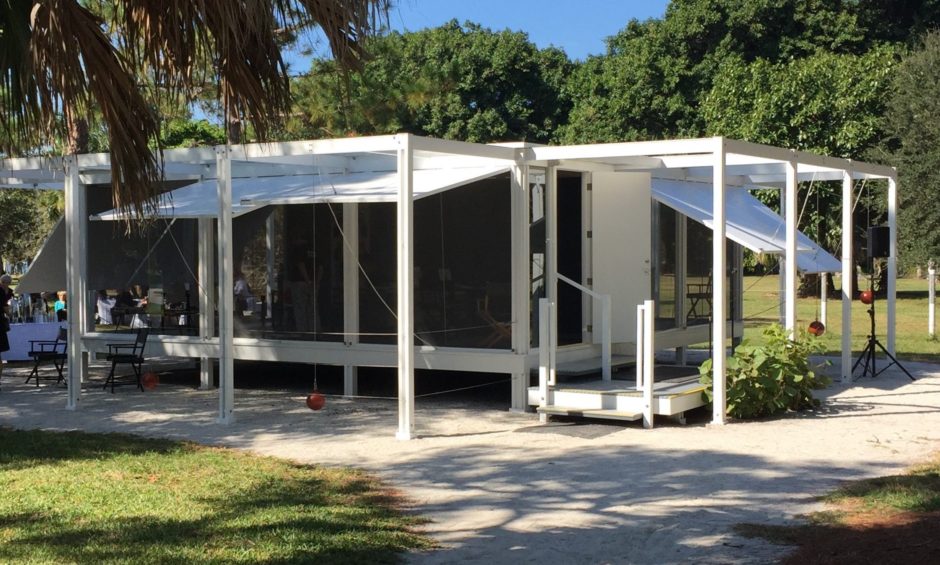 Paul Rudolph’s Walker Guest House, (Original on Sanibel Island, Florida), Reconstruction at The Ringling Museum of Art, Sarasota, Florida. Photo: James Merrell
Paul Rudolph’s Walker Guest House, (Original on Sanibel Island, Florida), Reconstruction at The Ringling Museum of Art, Sarasota, Florida. Photo: James Merrell
——————————————
Discerning the Rational from the Modern in Architecture
~~~~~~~~~~~~~~~~~~~~~~~~~~~~~~~~~~~~~~~~~~~~~~~~~~~~~
 On occasion one comes across a building that exceeds all expectations in demonstrating the importance of rationality, over style, in architectural design. That happened to me recently while attending SarasotaMOD 2016, an annual celebration of the mid-century modern architecture of The Sarasota School, in Sarasota, Florida. The specific building was Paul Rudolph’s Walker Guest House, from 1953; or more precisely, its replica.
On occasion one comes across a building that exceeds all expectations in demonstrating the importance of rationality, over style, in architectural design. That happened to me recently while attending SarasotaMOD 2016, an annual celebration of the mid-century modern architecture of The Sarasota School, in Sarasota, Florida. The specific building was Paul Rudolph’s Walker Guest House, from 1953; or more precisely, its replica.
Sarasota was home to Rudolph in the 1950s and 60’s, and his earliest and best loved houses dot the barrier beaches nearby. The Walker Guest House was built on Sanibel Island, and is very difficult to visit. But it is so loved by local architecture fans that they have funded a meticulous reconstruction of it, which now stands on the grounds of the Ringling Museum of Art. And there, one can marvel at its playfulness, examine its (few) spaces, and study its detailing. One can also experience the building’s “rationality” first hand.

The first key to understanding this design is to recognize that Florida beach houses in the 1950s did not use air conditioning! Seasonal cottages like the Walker Guest House needed to attract gulf breezes on a hot day. But they also needed to shutter up tight in a storm, and for the off-season. Rudolph’s design starts with this single challenge and provides a truly innovative solution: making the exterior walls operable. Fully two-thirds of the exterior walls are full height panels that are hinged at the top. When lifted 90 degrees they make instant “porches,” and reveal screen-walls for ventilation. But when dropped and secured these same panels batten down the house for a storm, or just for the off-season.
Structurally speaking, it is also important to note that the other third of the exterior walls is plate glass. Uniquely, Rudolph eliminated all solid exterior walls from this house. Equally ingenious is his system for operating these shutters. Wanting a shutter that was not just seasonal, but could be adjusted throughout the day for maximum comfort, Rudolph fitted them with cannonball counter-weights and a rope system that allows the occupant to adjust the position effortlessly from inside the house. As a result, when the sun moves across the sky, the “porches” and airflow can be “trimmed” as easily as the sails on a ship.
In this way, Rudolph’s design fulfills Corbusier’s dictum that the modern house be “a machine for living in.” But machinery alone does not make a house architecture, so Rudolph also brought his skills with proportion and order to bear. Looking closely at the elevations one sees three perfectly square bays on each side. And the plan is a perfect nine-square module. Here Rudolph recalls, for me, the “ideal” villa plans of Palladio. And the conceptual beauty of his structural system is as artful as it is practical. So, as it becomes clear with study, this little building demonstrates how architecture benefits when rationality takes precedence over style in design.
When people talk about architecture these days, I have noticed, there is a tendency to confuse, or perhaps conflate, the rational with the modern. In visual terms, surely, flat roofs tend to signal “modern.” And to be sure, Modernism started out as a rational proposition. But it is equally true that over the last century “modern” has come to stand more for a style of architecture than for the rational process that created it. And so we’ve lost touch with the distinction between the two.
The Walker Guest House, I believe, demonstrates this difference clearly. Like the drawings of Da Vinci, especially his drawings for machines of war and flight, it prioritizes thought. And in this way Rudolph’s design breaks free of modern conventions to find rational innovation in his own time. This, much more than his “modernism,” is what accounts for the timeless quality of the Walker Guest House today.
— By James Merrell · November 25, 2016
———————————————-
James Merrell Architects
66 Main Street, Sag Harbor, NY 11963
—————————–
Click here to view Learning From Houses: A Laboratory for Architectural Design
_____________________________________________________
